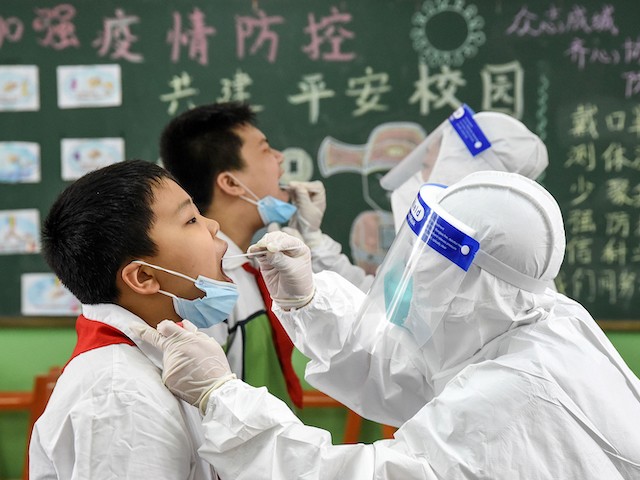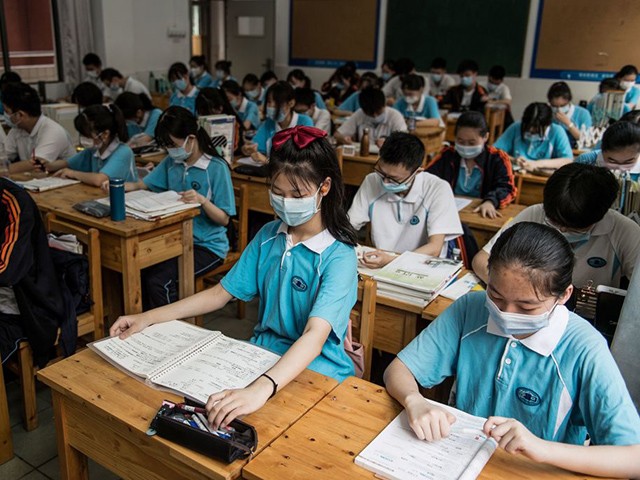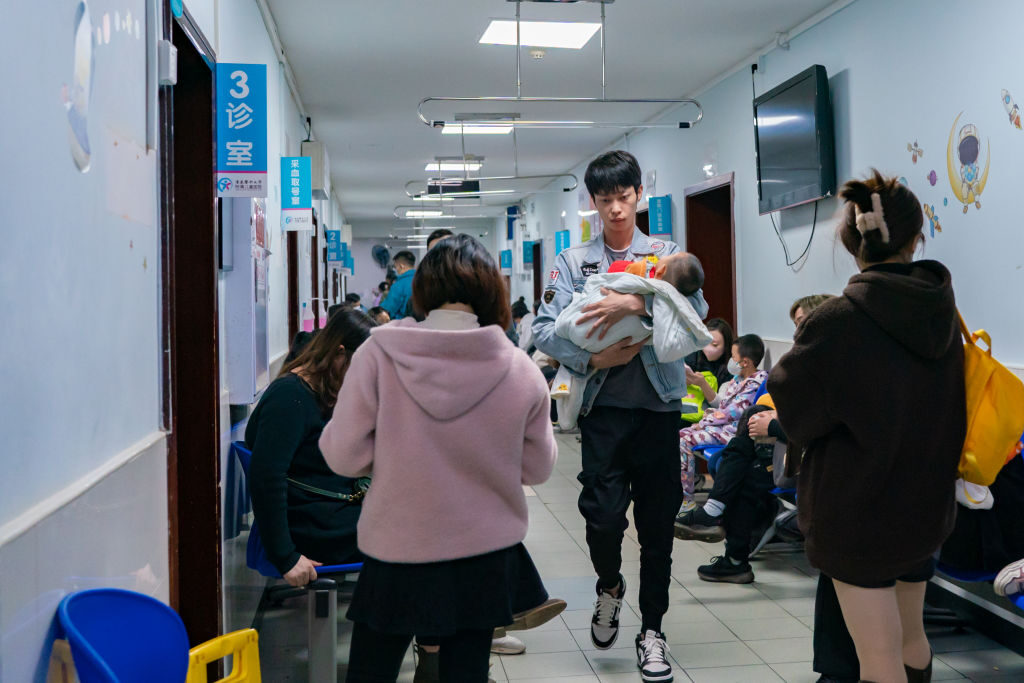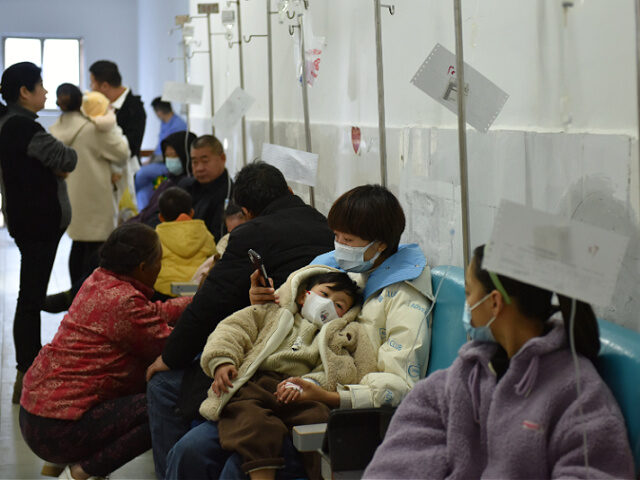Beijing’s local education authority sternly warned doctors and parents this weekend not to force sick children to attend school or assign overly burdensome homework to children who are ill, a response to a surge in child hospitalizations and respiratory illnesses throughout China.
Beijing, Shanghai, and much of the Chinese northeast have been experiencing a dramatic increase in the number of diagnosed cases of pneumonia and hospitalizations of individuals diagnosed with respiratory disease in the past month. Those cases have increased particularly among children, compromising the communist state’s education system and challenging overpopulated local hospitals.
The Chinese Communist Party has attributed the rise in pneumonia cases to the spread of various known pathogens including viruses — such as influenza, adenovirus, and respiratory syncytial virus (RSV) — and mycoplasma pneumoniae, a bacterial infection. The World Health Organization (W.H.O.) claimed last week that Chinese authorities have not documented the presence of any novel pathogens, such as the Wuhan coronavirus that caused the pandemic of 2020, in those affected by the ongoing wave of disease.
The Chinese government propaganda outlet Global Times, citing regime-approved “experts,” conceded last week that the prevalence of severe respiratory disease among children in the country could be attributed to an “immunity gap” created by China’s “zero-Covid” policy of placing millions under house arrest, forcing thousands into torturous quarantine camps and essentially outlawing free association for nearly three years. Many of the children most severely affected by these illnesses were born during the lockdown era, the Global Times observed on Monday, so their immune systems have not been sufficiently exposed to certain diseases and their bodies are not prepared with sufficient antibody counts.

This photograph taken on August 17, 2020, shows a medical worker taking a swab sample from an elementary school student, to be tested for the COVID-19 coronavirus. (STR/AFP via Getty Images)
China ended its “zero-Covid” policy in late November 2022 in response to a wave of mass protests nationwide.
The rapid increase in the number of cases of sick children diagnosed with pneumonia has been so dramatic that the Beijing Municipal Education Commission (BMEC) is urging schools to prepare for “a smooth transition between online and offline teaching” to keep children from being in the same room.
“Thorough health monitoring for both teachers and students should be conducted to make sure that no one attends work or class while ill,” the Global Times paraphrased the BMEC’s warning.
“Schools should not issue any mandatory requirements for student homework during illness, and should treat student health as priority,” the communist education authority reportedly demanded.
“Online teaching,” “virtual schooling,” or “remote learning” are methods of education that became prevalent throughout the West during the Wuhan coronavirus pandemic in which teachers interact with students via an online video link. The children then spend all day in front of a computer listening to their teachers, with no interaction with other students.

Students wear face masks as they study in a classroom in a high school in Wuhan in China’s central Hubei province on July 10, 2020. (STR/AFP via Getty Images)
In the United States, virtual learning and lockdowns “erased two decades of progress in math and reading,” the far-left New York Times newspaper declared in September 2022, citing data from the National Assessment of Educational Progress.
“That is very alarming. It’s disturbing. But it’s not surprising, keeping in mind a year and a half ago over half of our schools were not open for full-time learning,” Secretary of Education Miguel Cardona said in response to the report at the time. “In-person learning is where we need to focus. We need to double-down our efforts.”
Beijing’s education authority also felt it necessary this weekend to tell schools to “make student health the priority and not impose mandatory requirements on the assignments during their illness.”
In addition to the return of “online” teaching, the BMEC is demanding the return of the use of sanitary masks, “moderate” exercise in schools, and frequent hand-washing. The Communist Party began urging citizens to use sanitary masks again in early November, both to protect from the Wuhan coronavirus — which Chinese outlets mentioned only as a relatively minor threat compared to influenza and RSV this week — and mycoplasma pneumoniae.
“Currently, the top three respiratory diseases in children in Beijing are influenza, adenovirus, and respiratory syncytial virus,” the Global Times claimed.
The rise in respiratory disease cases has prompted the National Health Commission to order local Communist Party officials to invest in the development of more medical clinics to address demand.

Parents with children who are suffering from respiratory diseases are lining up at a children’s hospital in Chongqing, China, on November 23, 2023. (Photo by Costfoto/NurPhoto via Getty Images)
“Efforts should be made to increase the number of relevant clinics and treatment areas, appropriately extend service hours and strengthen guarantees of drug supplies,” National Health Commission spokesperson Mi Feng said on Sunday, according to the German outlet Deutsche Welle.
The Global Times openly admitted to a lack of resources to aid families, quoting parents in reports throughout November, quoting anonymous parents who lamented that hospitals were “fully packed” and did not have the capacity to attend to their children. The lack of available clinics, particularly in the capital, is a source of embarrassment for a regime that three years ago published dazzling propaganda videos allegedly showing the rapid construction of “makeshift” hospitals in Wuhan and other high-population areas.
Chinese state media have not at press time addressed the fate of those hospitals or if they are currently being used to treat pneumonia patients.

COMMENTS
Please let us know if you're having issues with commenting.